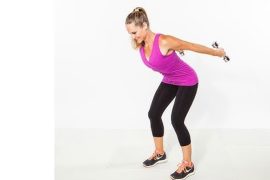The bench press exercise is one of the most potent pressing movements you can prescribe to a client. Whether you are a powerlifter, weightlifter, competitive fitness athlete, or just looking to improve in general physical capabilities, the bench press may be a powerful tool that can improve performance at any level of fitness.
The bench is the one exercise that will target multiple anterior and posterior muscles. The pecs, triceps, delts, and scapula are all targeted during this exercise which will give you the highest return as you work toward improving your’s absolute strength or upper body lean mass.
This exercise is often done with barbells, dumbbells, and speciality bars, and be performed at different loading angles to create a robust upper body chain. Utilizing the various variations of this movement will allow you to keep your training programs simple, and effective, and make a consistent positive adaptation for yourself.
What is a Bench Press Exercise
The bench press exercise may be a compound exercise that targets the muscles of the upper body. It involves lying on a bench and pressing weight upward using either a barbell or a pair of dumbbells. During a bench press, you lower the load down to chest level and then press upwards while extending your arms. This movement is taken into account by one repetition or rep.
There are several variations of bench presses that every work different muscles. These may involve lying flat, lying at an incline or decline, or placing your hands closer together on the barbell.
Effects of Bench Press Exercise on Muscles
- Traditional bench press – This exercise is completed lying down on a flat bench and pressing a barbell up and down at chest height. It works the pectoral muscles, shoulders, and arms.
- Incline bench press – For this variation, the bench should be angled upward between 45 and 60 degrees, so you’re leaning back slightly. It targets muscles of the upper chest and shoulders.
- Decline bench press – For this variation, the bench should be angled downward, so once you lie down your feet are in a higher position than your head. It works the lower chest muscles and shoulders.
- Narrow grip bench press – During this variation, your hands are narrower together on the barbell. It works the triceps and forearms.
 Best Bench Press Exercises
Best Bench Press Exercises
1.) Wide grip bench press – This bench press exercise targets muscles such as musculus pectoralis major, greater pectoral muscle, pectoral, pectoral muscle, pectoralis, musculus pectoralis. The wide grip bench press increases chest and shoulder engagement. If your bench press stalls with the bar near your chest, this exercise will help.
Steps To Perform
- Lie on the bench and hold the bar using an overhand grip.
- Your hands should be placed during a 12-18 inches wider grip than your regular bench press grip.
- Pull your shoulders down and back and brace your core.
- Drive your feet into the ground and lift your chest up toward the bar.
- Unrack the bar then lower it to lightly touch the high point of your sternum.
- Drive the bar copy and repeat.
2.) Paused bench press – This exercise targets muscles such as the musculus pectoralis major, anterior deltoids, and triceps. A lot of bench presses lower the bar fast and then bounce it off their chests. While this might help to lift more weight, it’s your muscle and joint elasticity that’s responsible and not muscle strength. Adding a mid-rep pause eliminates bouncing and forces you to boost the bar from a dead stop. This is challenging and a great way to increase strength and power off your chest. Powerlifters need to pause for their lifts to count, so this is often a valuable exercise if you want to bench press in competition.
Steps To Perform
- Set up as usual with your preferred grip.
- Unrack the bar.
- Bend your arms and lower the bar smoothly to your chest.
- Without relaxing or resting the bar on your sternum, pause for 3-5 seconds then drives the bar back up.
- The longer the pause, the harder the exercise becomes.
3.) Narrow grip bench press – This bench press exercise targets muscles such as the musculus pectoralis major, anterior deltoids, and triceps. If you discover it hard to lock out your elbows at the end of a bench press rep, your triceps might be your weak link. Narrower grip bench presses increase triceps recruitment for a stronger lockout.
Steps To Perform
- Lying on the bench, reach up and hold the bar employing a shoulder-width, overhand grip.
- Do NOT place your hands so close together that your thumbs are almost touching.
- That’s too narrow and puts unnecessary strain on your wrists and elbows.
- Unrack the bar and lower it to the part of your chest.
- Drive it to copy and repeat.
- You can also do this exercise with a mid-rep pause to increase explosive power.
4.) Spotto bench press – This exercise targets muscles such as the musculus pectoralis major, anterior deltoids, and triceps. This exercise increases chest strength and offers explosive power to the upper body.
Steps To Perform
- Set up as usual with your preferred grip.
- Unrack the bar.
- Lower the bar as was common but then stop with the bar about 8-12 inches above your chest.
- Pause for 1-2 seconds then drive it back up.
5.) Bench press with chains or bands – This bench press exercise targets muscles such as the pectoralis major, anterior deltoids, and triceps. Benching with chains or bands increases the load on your muscles as you approach lockout. This increases triceps activation and also means you’ll really drive the bar powerfully off your chest, blasting through any potential detail. This is a very specific assistance exercise for bench presses.
Steps To Perform
- Attach a sequence or band to both ends of your bar.
- Start light as benching with chains and bands are often very challenging.
- Set up as usual with your preferred grip.
- Unrack the bar.
- Lower the bar to your chest then drive it back up to full lockout.
6.) Dumbbell bench press – Dumbbell presses allow you to continue performing on your strength while avoiding repetitive movements that can lead to shoulder injuries. Use dumbbell bench presses to feature variety in your workouts.
Steps To Perform
- Lie on a bench with a dumbbell in each hand, arms straight, and palms facing down your body.
- Brace your abs, pull your shoulders down and back, and drive your feet into the ground.
- Bend your elbows and lower the weights to your shoulders.
- Push them copy and repeat.
- Add variety to your dumbbell bench press workouts with these variations
7.) Parallel bar dip – If your triceps are your weak link, dips can help. They are also a useful chest exercise because they use a special movement pattern, and dips also are helpful for adding variety to your upper body workouts.
Steps To Perform
- Grip the bars together with your palms facing inward.
- Support your weight on straight arms.
- Bend your legs and cross your feet if you would like.
- Bend your arms and descend until your upper arms are roughly parallel to the ground.
- Push yourself copy and repeat.
8.) Push-up – The humble push-up is a useful bench press assistance exercise. Because no equipment is required, you can do it almost anywhere and anytime, so it’s convenient thanks to increasing chest, shoulders, and triceps training volume without having to travel to the gym.
Steps To Perform
- Squat down and place your hands on the ground, fingers pointing forward and slightly wider than shoulder-width apart.
- Walk your feet back, so your body is straight.
- Brace your abs.
- Bend your elbows and lower your chest right down to about an inch above the floor.
- Push yourself copy and repeat.
- Add variety to your push-up workouts with these variations
9.) Face pull – Face pulls are one of the best upper back exercises. They’re also excellent for shoulder health. A big bench press requires a stable platform. That doesn’t mean the bench but your upper back muscles. A strong upper back will add a lot to your bench press performance and reduce your risk of acute and chronic injury.
Steps To Perform
- Attach a rope handle to an adjustable pulley machine set to about shoulder height.
- Hold the handles together with your thumbs touching the end stoppers.
- Extend your arms and step back to a staggered stance.
- Pull your shoulders back and down.
- Keeping your torso upright, bend your arms and pull the handles into the side of your head.
- Imagine you’re trying to put your thumbs in your ears.
- Straighten your arms and repeat.
- You can also do this exercise using a resistance band.
10.) Band pull-aparts – As face pulls, band pull-aparts target the muscles of your upper back. However, all you would like is a resistance band to do this exercise, so it’s ideal for home workouts. Do some sets of band pull-aparts every day to strengthen your upper back and preserve shoulder health.
Steps To Perform
- Hold a resistance band with an overhand, shoulder-width grip.
- Raise your arms and call in front of you.
- Pull your shoulders back and down.
- Open your arms and stretch the band out across your chest.
- Return to the starting position and repeat.
Disclaimer:
The information contained in this article is for educational and informational purposes only and is not intended as a health advice. We would ask you to consult a qualified professional or medical expert to gain additional knowledge before you choose to consume any product or perform any exercise.









